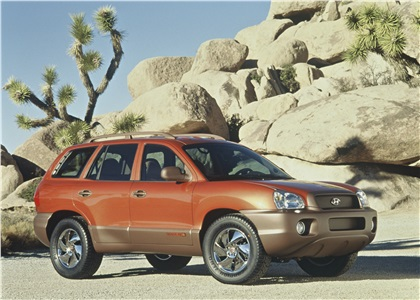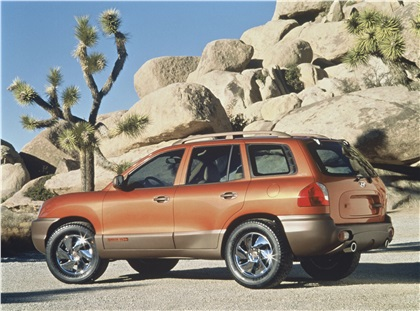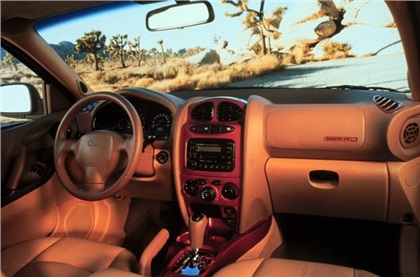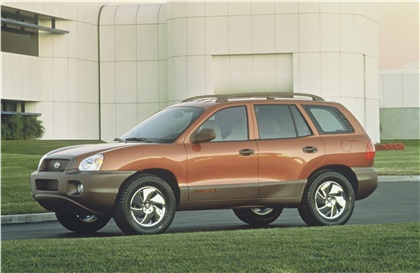1999 Hyundai Santa Fe
- Story Cars

- Oct 5, 2021
- 3 min read
Concept SUV Loaded with Class-Leading Features, Demonstrating Hyundai's Commitment to the U.S. Market
DETROIT, Jan. 5, 1999 - Hyundai marks its first step into the expanding sport-utility vehicle market with today's worldwide debut of the "Santa Fe" concept SUV at the 1999 North American International Auto Show in Detroit.
The Santa Fe is the first SUV designed, engineered, and developed by Hyundai, South Korea's leading automaker. A production version of the concept vehicle will go on sale in the spring of next year at Hyundai dealerships across the United States.
"With the Santa Fe, Hyundai has demonstrated its continuing commitment to the North American auto market by researching and developing an SUV that will be sold primarily in the United States," said Finbarr O'Neill, president, and chief executive officer of Hyundai Motor America.
THE SANTA FE CONCEPT
The Hyundai concept SUV is named after the capital city in the American Southwest, known both for its rugged Western character and its sophisticated design and style sense. Taking its name, logo, and styling cues from the spirit of the U.S. Southwestern desert, the Santa Fe features bronze and terra cotta body colors, a sand-toned leather-wrapped interior, and even a warm-chrome finish on its windmill-style alloy wheels.
The Santa Fe is powered by an all-aluminum, 24-valve, double-overhead-cam V-6 engine, transversely mounted. The transmission is a four-speed, electronically controlled, fully adaptive automatic.
Power is transmitted to the wheels through an electronically controlled, all-wheel-drive system with a viscous coupling that seamlessly engages the rear wheels for added traction when needed -- without any input from the driver.
The Santa Fe has a MacPherson strut front suspension. At the back is a semi-trailing arm rear suspension.
The Santa Fe shows Hyundai family resemblance to the Tiburon coupe and Sonata sedan with solid character lines over the front and rear wheel wells. At the same time, Santa Fe's body-side contours recall a desert landscape and give the Hyundai a more styling personality than traditionally angular SUVs.
Big 17-inch wheels and tires supply Santa Fe with an aggressive stance on the road, and large oval headlamps are placed at the corners of the front end to create an image of size and presence.
The Santa Fe is similar in size to the Isuzu Rodeo, Honda CR-V, and Toyota RAV 4. Designed to meet the driving demands of most SUV buyers, the Santa Fe was built to drive like a car, with a definite on-road focus, yet serve as an excellent vehicle in all weather and limited-traction conditions.
AN INTERIOR CREATED FOR CONVENIENCE AND SAFETY
The Santa Fe boasts several everyday convenience items to please SUV buyers.
In addition to universal-size cup-holders, the Santa Fe is equipped with water bottle holders. Unusual "free-floating" door handles make exits easier while side pockets with lids sit beneath the armrests. Two 12-volt in-dash outlets, and one placed in the rear, address various electrical accessory needs. Also in the back is a handy lift-out picnic table, accessible through the large rear hatch mounted on telescoping struts. The spare tire stows out of the way beneath the rear of the car.
The Santa Fe has essential safety features, such as second-generation, depowered dual frontal airbags. A Passenger-Presence Detection system shuts off the passenger-side airbags when a small child, or no one, is in the seat. The front seat belts also come with automatic pretensioners to cinch the belt in the event of a collision.
DESIGN AND CONSTRUCTION
A team of designers at the Hyundai California Design Center created the original Santa Fe. The vehicle was designed in the United States because America has been the home of the sport utility vehicle. However, trends worldwide were carefully analyzed during the research and design phases of the vehicle's preparation.
Hyundai's other design centers in Germany, Tokyo, and Seoul were consulted during the project, and their input was incorporated into the final design. Italdesign California Inc. (IDC) was the fabrication and preparation partner for the concept vehicle.
Hyundai Motor America, based in Fountain Valley, Calif., is a subsidiary of Korea's Hyundai Motor Company. Hyundai cars are distributed in the United States by Hyundai Motor America and are sold and serviced through nearly 500 dealerships nationwide.
Source: Hyundai




































Comments